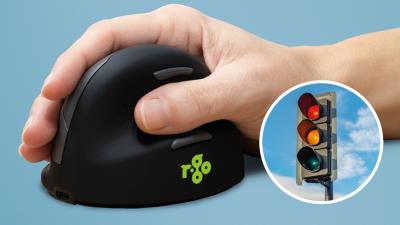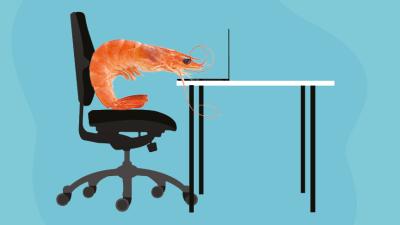
Back ache and ergonomic chairs; these are the two discussion topics where you might most often hear the word ‘lumbar’ crop up. Don’t fear if you don’t really know your lumbar vertebrae from your thoracolumbar fascia. In this interview, Posturite Lead Ergonomist Katharine Metters gives us a helpful intro to the lumbar region of our backs.
We’ll highlight the lower back’s importance in the human anatomy and why it’s vital to take care of the lumbar region of our backs at work as well as in leisure time.
You know that musculoskeletal disorders are a major cause of work-related ill health – just remember that they are usually preventable. 32% of all reported work-related health issues in 2023/24, with an estimated 543,000 workers affected, were musculoskeletal disorders. 43% of these cases affected the back.
So let’s hear Katharine’s answers to some key questions about the lumbar region:
What is the lumbar and where is it?
The lumbar region is the lower section of your back, the region around the lower five vertebrae of your spine.

The lumbar region encompasses all the tissues in the area including the discs, ligaments, muscles and nerves, as well as the bones.
Your spine is made up of 33 vertebrae that are divided into five main regions. Here they are from top to bottom:
- Cervical: The top seven vertebrae in your neck
- Thoracic: The 12 vertebrae in your upper back
- Lumbar: The five vertebrae in your lower back
- Sacrum: Fused 5 vertebrae that connect your spine to your pelvis
- Coccyx: 4 very small bones usually fused together
The inward lumbar curve is created by the lumbar region, and it is the way that the bones and joints are situated that creates the curve, in conjunction with the muscles and the weight distribution. Maintaining this gentle curve is the efficient way for the structures and the body work together. Everyone adopts a very slightly different curve. The ‘neutral’ curve that we’re after is neither flat nor excessively curved.

Why is your lumbar region such an important area of your body to look after?
Because it is so integral to everything we do. I’d say the lumbar region may be the most important part of your body to look after, or equal perhaps in importance to your neck.
The lumbar region is right at the heart of our body, and is key to us doing everything that we want in life – walking, balancing, and so on, and we don't have many workarounds. If there’s a significant problem it affects everything; you often can't sleep or sit, coughing and sneezing hurt, you can't get around or do what you want to do. You can’t just put it in a sling or plaster cast if you injure it!

At the front of your body are the abdominal muscles, to the side are the obliques and behind is your lumbar region, so if there's something wrong with your abdominal muscles, it affects your lumbar spine, its support and its position. Quite often, strengthening your abdominal muscles helps the back pain go away, because your position is improved and you've got support at the front of the body.
Can having weak abdominal muscles lead to lower back pain?
Yes, absolutely. Because what happens is your lumbar curve tends to become more pronounced because you don't have the support at the front. Everything will be out of alignment slightly and your pelvis may tilt more forwards. You have to have that core stability. If you've got no support from your core muscles, then everything is left a bit unprotected.
Core-strengthening exercises to strengthen and improve the co-ordination of your core (including your abdominal muscles) will be of great benefit to the lumbar region of your back.

Using exercise balls can be great for this! As is Pilates, for example. Abdominals are so vital to supporting the lumbar spine.
Is pain in the lumbar region the most common kind of back ache?
Yes, and actually almost 2 in 3 people have pain in their lower back at some point. It’s more common to have discomfort in the lower than the upper back.
I’ve experienced lower back pain myself and it was dreadful! I actually managed to prolapse a disk. It took me nearly 8 weeks to recover, and I went to the doctor, took painkillers and anti-inflammatories and managed to keep moving gently. I gradually increased what I could do. You can't argue with a piece of tissue, and I had to be very sensible – very difficult for me! – and avoid irritating it. I had to rest to begin with and just worked on simple but frequent slow movements. I was lucky that I was able to work through most of my recovery as I had a Capisco chair allowing different positions and a sit-stand desk at home to allow me to stand and perch for periods to work. If I hadn't had the adjustable desk and a chair that I could sit and perch on in different ways and accommodate my pain, it would have been a very different thing. In the beginning I did also lie on the floor to take calls and this allowed me to do simple exercises too.
I am happy to say that my back does not stop me doing what I want now, although I am sensible like we all should be.
How can you look after your lumbar region at work?
First and foremost, plenty of movement. Try active working and don’t stay sitting all day. Change your posture regularly and take frequent breaks.
Because sitting really puts quite a lot of pressure on your spine, and without the benefits that you get from standing and walking around. So it’s great for your lumbar region to be active while you work.
Do stretching, keep your mobility, keep your flexibility and your balance; keep it coordinated so that when you do trip or something, your body can react to that.
Drinking water is good. Smoking's not good of course.
If you do office work and use a traditional office chair, take care to set up your workstation so that your lumbar region is in a good position and well supported:
- If you're sitting, make sure you have the curve in your spine supported so that you're able to sit back in your chair and you can feel support from the ergonomic chair in the lumbar region of your back. Make sure your lumbar region is touching the chair back and supported by it.

- Make sure that your hips are slightly higher than your knees when sitting, otherwise it's very difficult to maintain your lumbar curve. Then your pelvis can be in the neutral position - encouraging the lumbar spine to be in the right position. A good diagram to guide you on optimal workstation positioning is here.
Remember that an ergonomic chair is one that fits you and fits the task that you do. Choose your ‘office’ chair carefully, invest in quality and adjustability because the health and comfort of your back is important and you need to protect it.
There are chairs that work by positioning the body in balance without providing support from a backrest – these are kneeling chairs and saddle chairs.
Using a sit-stand desk to work will usually benefit your lumbar region too. Because changing position and having periods of standing will help reduce the pressure through your discs. If you stand well, it also encourages movement and it’s also those small movements, that keeps the coordination trained. It helps you reduce the amount of passive sitting that you do.
But it's important to vary your movement throughout the day, not choose to stand all day, and not choose to sit all day. So lots of regular rotation is the key to it. It’s like mini exercise throughout the day without really thinking about it!
What does an ergonomic chair do to make your lumbar region feel comfortable?
The ergonomic chair helps to position your lumbar region correctly, and it also then provides support to maintain that position and reduce fatigue.
If you lean against the chair’s backrest, you are transferring some of your body weight through the mechanism of the chair, into the chair base and down into the floor. Whereas as soon as you lean forwards, you're not.
It’s a good thing for the chair to take some of your weight, because we don't want that pressure going through your spine. It's literally taking a load off and we use the word ‘support’ so much and I don't think we ever stop and think actually, what do we mean by it?
People who sit forwards on their chairs can't get support because they’re not transferring the weight to the chair.
What’s an adjustable lumbar support?
An adjustable lumbar support is available on some ergonomic chairs. It is a lumbar support cushion in the back of your chair connected to a little black rubber pump. You inflate or deflate it to adjust the depth and firmness of the cushion. It provides you with the amount of lower back support that you want – however much feels good to you.

For example, there’s a lumbar pump on the Positiv Me 300 High Back Office Chair.
Some people even like to vary their lumbar support firmness during the working day.
Can a good ergonomic chair prevent pain in the lumbar region?
It certainly lowers the risk of pain, yes.
The ergonomic chair and positioning yourself correctly in it is one element in your overall approach to good back health.
And can a good ergonomic chair resolve pain in the lumbar region?
In combination with other measures, yes. The chair can help reduce the back pain when you're struggling and you need support. It could prevent the pain getting worse because you've got support.
Can it solve the underlying problem? No, but it could give the body its best opportunity to use its own resources to bring the blood supply and everything else.
Follow your doctor’s and therapist’s advice and do your exercises, take your painkillers and your anti-inflammatories if they’re recommended. The suitable chair and good posture are part of the package.
Are there different types of lumbar support provided in ergonomic equipment?
Yes, lumbar support can be fixed or adjustable on an ergonomic chair. Adjustable lumbar support (height, depth and firmness) is great in hot desking workspaces because the support can be adjusted to suit different people on a different day.
The HÅG SoFi 7500 Mesh High Back Task Chair features adjustable lumbar support on a ratchet system, which you can easily slide into the correct position.
And the excellent RH Logic 300 ergonomic chair comes with a lumbar pump to adjust the lumbar support.
If you find yourself working somewhere temporarily where you don’t have an ergonomic chair to support your back, you could use a posture support such as a Lumbar Roll as a handy lumbar support quick fix.
Will an ergonomic chair which promotes movement help your lumbar region?
Yes, remember that your lower back loves movement. So you could choose a chair which has an in-built mechanism to allow the chair to move naturally with you. The RH Extend 120 (high synchro back) Ergonomic Office Chair, for example. The movement can also stimulate oxygen and blood-flow through your body, so can help keep you alert and energised during your working day.
Thank you to Katharine Metters from Posturite for explaining lumbar support briefly to us here. She is a consultant to clients on ergonomics and health and safety, and trains Posturite’s DSE assessment team to troubleshoot employees’ discomfort in the workplace.
Read next:















